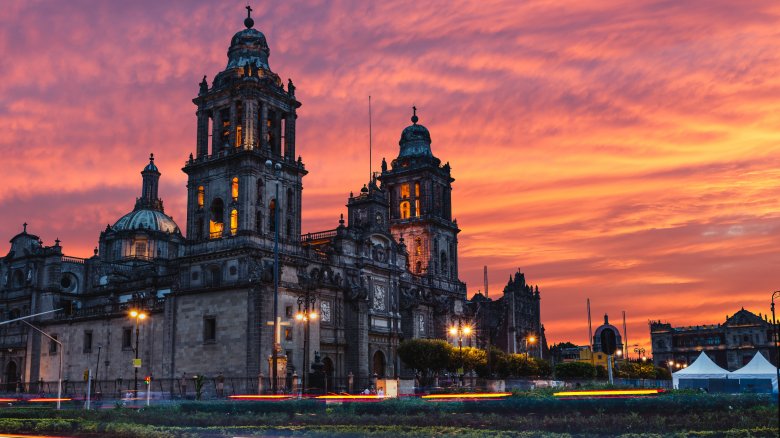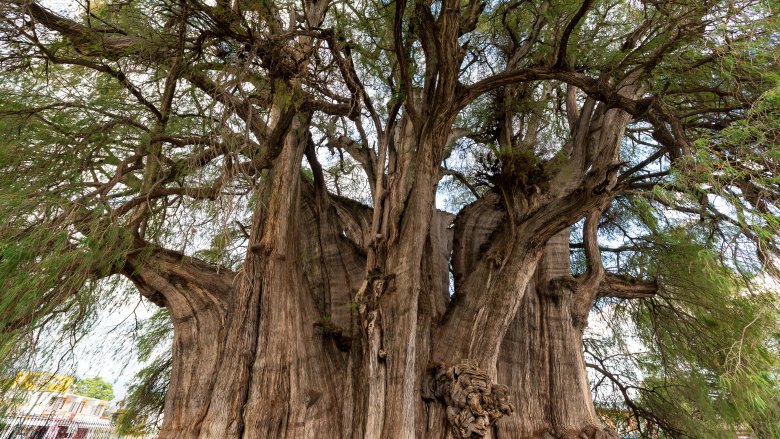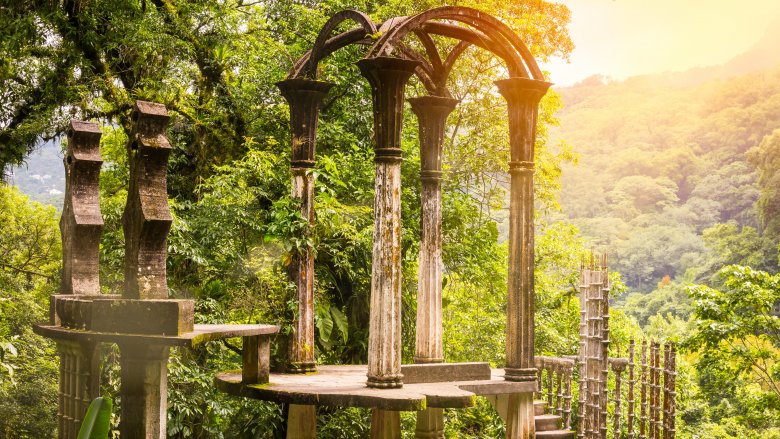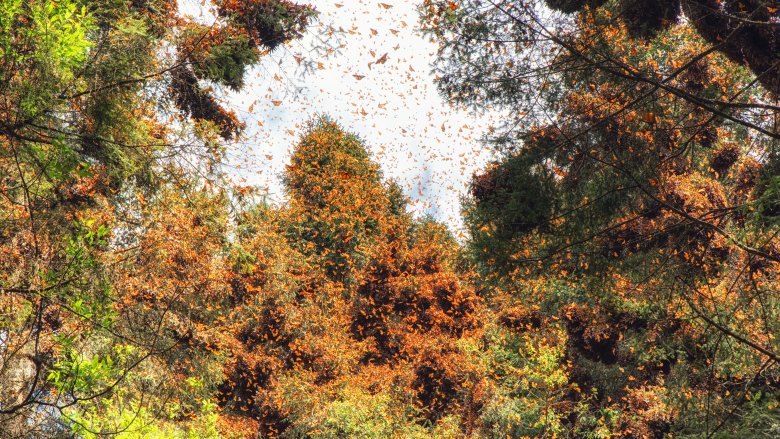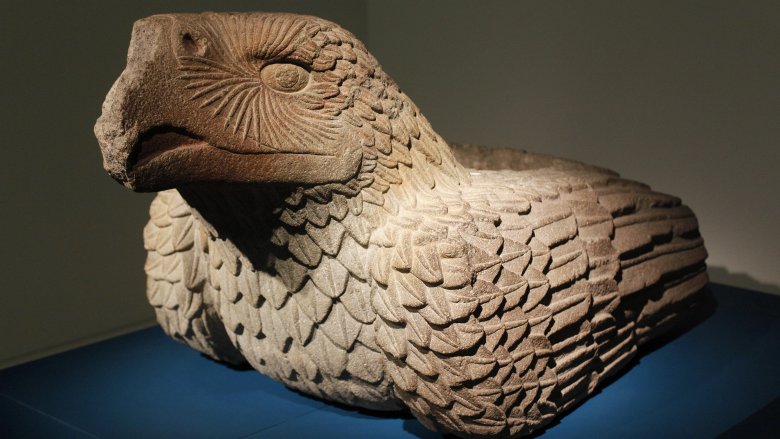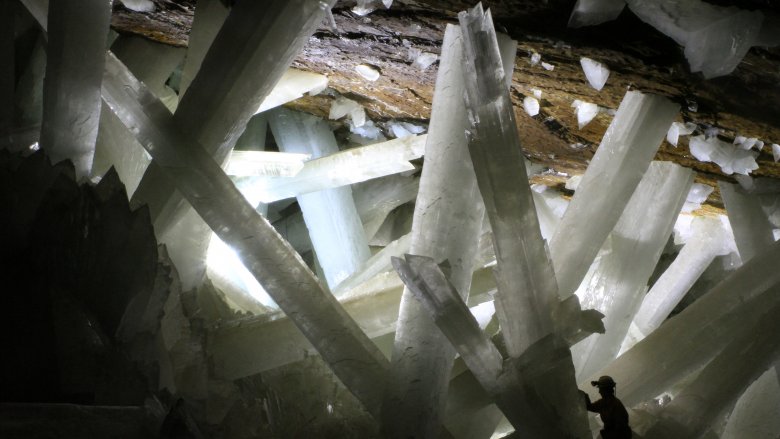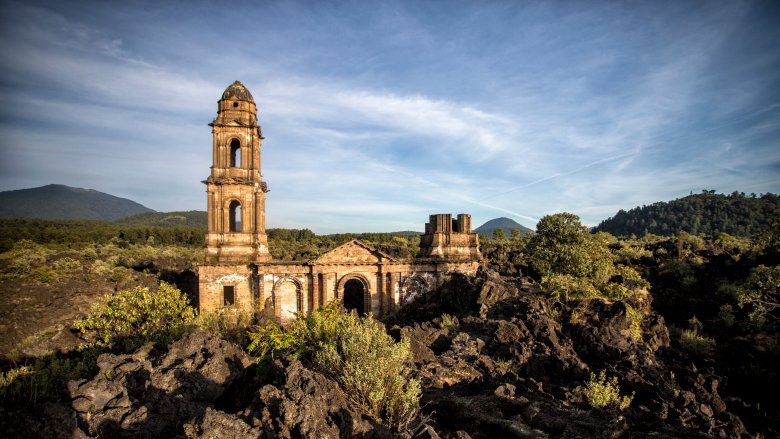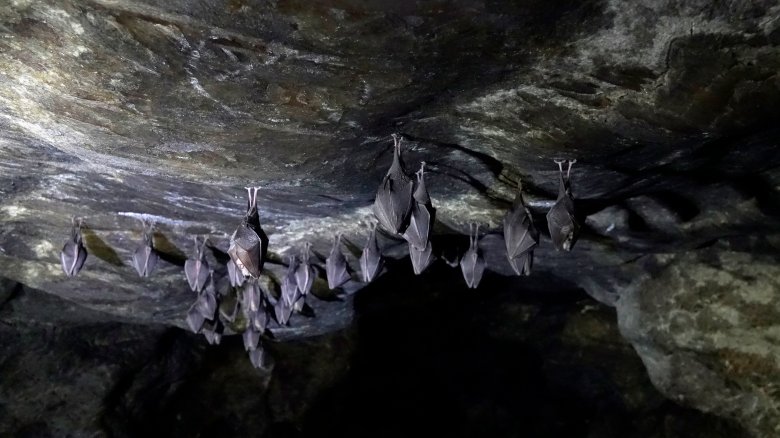Bizarre Things That Only Exist In Mexico
Mexico is a lovely nation with a treasure trove of cultural and geographic gems to explore. It is also a wonderfully wacky place where seemingly impossible events and artifacts seem as common as a Pidgey outside of Pallet Town. Tomato-like fruits with a texture and flavor like chocolate pudding are as mundane as a half-squeezed packet of Go-Gurt would be to the rest of the world. Venturing past an Aztec snake god-shaped apartment complex might not merit a second glance, and as for the charming National Museum of Death? Roughly as interesting to the average Mexican citizen as a Quicken Loans Trial Version Starter Guide.
With at least 10,000 years of time for human settlers to cook up zany cultural quirks and countless millennia more for Mother Earth to manifest natural wonders, there are many lifetimes worth of beautiful, shockingly absurd things to see. So, despite what some world leaders might say, this country and its inhabitants are as golden as the oldies. Just avoid portals to the underworld and predatory beasts, and you'll be in for the trip of a lifetime in Mexico.
Dinosaur death hole
You may not have heard of Chicxulub Crater, but you've probably been familiar with its work since toddlerdom. Located in what's now the Yucatan Peninsula, scientists pinpointed Chicxulub (pronounced CHEEK-she-loob) as the 110 mile-wide impact crater of the asteroid that deleted the dinos. It's the reason we don't have a Jurassic Park.
While that's kind of a bummer, it's cool to imagine the scale of the destruction a miles-wide asteroid can cause. With an explosion estimated to be equivalent to 100 million megatons of TNT, this once-every-100-million-years event created tsunamis over 330-feet high and sent debris straight out of the planet and into the solar system. What debris didn't fully escape Earth's gravity would have become superheated upon atmospheric reentry, literally raining fire on the planet. Combine that with massive earthquakes, eruptions, and a cloud of ash that choked the planet for about a decade and you've got a mass extinction.
The crater is so big you can't even tell it's a crater with the naked eye, so despite being discovered in the 1970s, its historic significance has only recently became accepted by the scientific public. Some of the more interesting evidence today includes tektites, cooled molten debris that solidified into naturally formed glass, and shocked-quartz, a uniquely structured crystal formation found in impact craters, lightning strikes, and nuclear test sites.
As Encyclopedia Britannica describes, Mayans would use cenotes — water-filled sinkholes that formed around Chicxulub's rim — for ritual sacrifice, keeping its deathly legacy alive.
The Festival of Exploding Hammers
The town of San Juan de la Vega hosts an annual tradition straight out of Gallagher's fantasy-bank. The Festival of Exploding Hammers is a 400-year-old tradition with understandably fuzzy origins, probably due to the myriad concussions it has undoubtedly caused. According to a Wall Street Journal report, there was a wealthy rancher and miner, Juan de la Vega, who was aided by patron San Juan de Baptista in recovering gold stolen by bandits. This Robin Hood-like triumph got the people pumped up, and an explosive victory celebration was born.
There are no watermelons to smash, but participants take turns wielding explosive hammers in honor of Juan's de la Vega's victory. The New Yorker paints a picture of enterprising lads taking turns strapping fireworks, fertilizer, and sulfur packs to hammers and smacking them on metal objects, often sending both hammer and hammer-holder flying. Police officers and medics patiently wait for the inevitable shrapnel wounds, which also dictate when the festival ends. When too many get hurt, the party's over until next year.
Witness the world's most massive Tule
For those who love huge, old trees, there is no sight greater than El Árbol del Tule (The Tree of Tule). Located on church grounds in the center of the Oaxacan town of Santa Maria del Tule, this gargantuan Montezuma cypress is the thickest tree in the world. Call it "Girth Barks" if you like. Clocking in at 137.8 feet wide and 46 feet across at its widest point, the tree is sometimes nicknamed the "Tree of Life," and some claim there are images of jaguars and elephants visible on its trunk. DNA tests have confirmed that the mammoth Tule is in fact one tree rather than two trunks that have grown together as was once claimed.
Scientists estimate its age to be between 1,433 and 1,600 years old, corresponding with claims that it was planted by an Aztec priest named Pecocha around 1,400 years ago. Several decades ago, some feared the tree was dying due to pollution, water shortages, and automobile traffic. But it's been going strong in the years since, so perhaps it can continue to survive human influence.
An adorable little volcano
The city of Puebla is home to Cuexcomate, a darling little volcano that is technically a "geyser." At 43 feet tall and 56 feet deep, you could just pinch its little cheeks. The false-volcano is composed of 99% calcite and was supposedly formed in 1064 during the eruption of Popocatépetl.
Despite its questionable volcanic status, Cuexcomate is known to most as the world's smallest volcano and boasts a few local legends that vary in degrees of cuteness. Cuexcomate translates to "a small bowl to save things in" (cute), and indigenous peoples did just that with the formation, as the temperature was cool enough for grain storage. Later on, Spanish colonists would use it to dump bodies of suicide victims in, which would supposedly send them straight to hell. Decidely not cute.
Dormant since the mid-1600s, you can now enter "the devil's bellybutton" via a spiral staircase, where you'll find an underground stream and waterfall pouring into a deeper hole.
A unique cross-country experience
An experience like no other, Parque Ecoalberto is a scenic resort park that offers a cheeky twist. As described by the New York Times, the native Hña Hñu tribe that runs the park provides the only authentic border-crossing experience in the world, during which you are led on a four-hour midnight trek through rough and unforgiving terrain.
While there is no such thing as a typical experience on the caminata nocturna ("night walk"), Business Insider says you can expect your gruff guide to stop you mid-run in order to hide from animal predators or border patrol officers or drug cartel members. You might also be chased by trucks and shot at with blanks after witnessing a fake cartel assassination. It's not real, of course, but it's also not really supposed to be fun, as the goal is to simulate the stress and fear that true border-crossers experience.
According to the park's website, the ultimate goal is to raise awareness and encourage citizens to seek a productive life in Mexico rather than risking it all. If you do choose to pay the roughly $16 for this experience, keep in mind that while your life is not at risk, it's not meant to be a joke!
A holy Mexican mushroom
Lots of people have seen god on 'shrooms, but there's only one place in the world where you can literally see the image of Christ on a mushroom, and that place is the Santuario del Honguito in Ixtlahuaca, Mexico, where villagers built a church devoted entirely to a holy mushroom.
The legend of Iglesia Del Honguito began in 1880, when a foraging peasant came upon the tiny fungus with bruises on its crown that vaguely resembled Jesus on the Holy Cross. Needless to say, the honguito (meaning "tree ear") caused quite a stir in the community, and a star was born. As Huffington Post details, a church was erected on the point of discovery, and an annual festival is held on July 24 to celebrate the miraculous revelation.
Visitors can still view the now-petrified mushroom, encased in glass, and may use the optional magnifying glass beside it to help them get a better view and decide for themselves.
Eccentric Englishman's dreamworld estate
An Instragrammer's heaven, Las Pozas is a sprawling Mexican estate built on a former coffee plantation by eccentric English poet and artist Edward James and turned into a wonderland of whimsical gardens and sculptures blended into a tropical rain forest backdrop. James' life was charmed, to say the least. Rumored to have been related to English royalty, he was born to vast wealth, which he would use to sponsor Surrealist artists like Salvador Dali. He would eventually sell his collection of Surrealist art — including works by Picasso, Magritte, and Dali — to fund the construction of Las Pozas, which cost over $5 million.
W Magazine describes the first version of his tropical haven as an estate devoted to the cultivation of tens of thousands of orchids, but after losing them all to a freak jungle snowstorm, James decided to build something a bit more hardy. The result was more than 30 monolithic sculptures with names like "Temple of the Ducks" and "The House With a Roof Like A Whale," often inspired by his enthusiasm for Surrealist art. A trip to the property will have you weaving in and out of totem poles, staircases to nowhere, and the seamlessly integrated natural pools from which Las Pozas get its name, wondering all the while whether you're dreaming.
Woodstock '69 for butterflies
If you've ever heard David Attenborough's voice, chances are you've caught a glimpse of the Monarch Butterfly Biosphere Reserve, the final destination for up to a billion monarchs each year.
Come late summer, the entire North American population of this ubiquitous species heads to Mexico for a 1,000-mile journey spanning four life cycles. This trek is not for mere recreation, but rather procreation. That's probably fun for the butterflies, but for humans the amazing part is from the romantic beauty of the journey and the breathtaking visual display that follows.
Channeling their free-loving spiritual side, butterflies cluster on pine trees to such a degree that the trees are hardly visible and branches bend from their collective weight. So numerous are the monarchs at this UNESCO World Heritage site that their flapping wings sound like rainfall. Once the deed is done, the butterflies begin their trek back northward, spanning another four monarch generations that have to hear tales of their parent's wild, young and free escapades. "It was a different time..."
Sacrificial heart storage units
Remember that scene in Indiana Jones where the guy gets his heart ripped out as a sacrifice? That stuff actually happened in Mexico, and we have souvenirs to commemorate those joyous occasions.
The once-common cuauhxicalli, which translates to "eagle gourd bowl," is an altar featured in Aztec shrines in either the form of an eagle or jaguar. A particularly majestic jaguar sculpture can be found in Mexico City's National Museum of Anthropology, not far from where it was discovered, featuring a large bowl in its back which was used to hold human hearts freshly ripped out of sacrificial victims' chests. After carving out the hearts and placing them in the jaguar, high priests would then burn them as an offering to the gods, who were undoubtedly delighted by the image of a predatory beast bowl full of flaming human hearts.
According to a report by art historian Manuel Aguilar Moreno, cuauhxicalli are "dedicated to the underworld, the earth, and the deified kings of the past." Back in the day, Aztec kings would wear jaguar skins to maintain an association with the regal creature, and are thought to have kept them in personal zoos. While the jaguars probably weren't too happy with this arrangement, an Aztec palace would have made for one awesome episode of Cribs.
Superman's man cave
Discovered in 2000 near Naica mine in the Chihuahuan desert, the Cueva de los Cristales (Cave of the Crystals) is home to one of the world's most stunning works of art. Located 1,000 feet below the Earth, the cave is filled with massive gypsum crystals up to 36 feet long that weigh up to 55 tons, according to the BBC.
Arranged in a chamber that National Geographic describes as roughly the size and dimensions of a basketball court, these ballin' natural wonders formed over hundreds of millennia from submersion in mineral-rich water at a stable temperature of 136 degrees Fahrenheit. The water contained a large amount of the mineral anhydrite, which slowly formed the gypsum crystals now on display. Interestingly, the BBC also tells us researchers were able to extract and reanimate bacteria trapped in the crystals, finding they shared little in common genetically with known life.
Unfortunately, both the giant crystal cave and its baby brother, the Cave of Swords, are currently closed to the public. Since it's naturally filled with water, the crystal cave had to be continually pumped to be accessible. Removing the water also meant the crystals stopped growing, so it has since been allowed to reflood. That's probably for the best, considering the cave's extreme humidity meant visitors ran the risk of death without a special cooling suit. Even with the suits, you'd only last 20-ish minutes before passing out. Best to leave this beauty for the crab people.
The church that Satan couldn't stomach
On February 20, 1943, a volcano emerged from the middle of a cornfield and began a slow eruption that would eventually swallow two towns whole — except for one building. Years after all the townsfolk had evacuated and built a new church, the church of San Juan Parangaricutiro remained standing, despite being half-eaten by molten lava. What remains is the surreal upper torso of a church, with an altar and tower perfectly preserved atop a bed of cooled lava rock from Parícutin, which also happens to be the youngest volcano in the world. There's actually footage of the eruption in the background of a major Hollywood motion picture titled Captain from Castile, caught about four years into the event.
It took about a year for magma to reach the church and begin devouring the cemetery and lower portions, and another eight years for the volcano to settle down, but despite the abuse, the church turned the other cheek, becoming a powerful symbol to the villagers. Nowhere else in the world will you find such a striking image of a church unseparated from state, existing truly as a testament to both the flame-retardant qualities of Christ and the time Satan got acid reflux.
A snake's take on in-flight meals
Often described as the Cave of the Hanging Snakes, Kantemo Cave conjures up the image of a social hub for serpents. However, this cave is home to one of the world's most entrepreneurial reptiles: the yellow-red rat snake. With returns on ground-dwelling rodent "ingestments" drying up, these savvy invertebrates decided to develop new real estate, which locals call the Bat Cave. Here's their business model. According to National Geographic, Phase 1 involves crawling up into nooks and crannies in the walls and ceiling, then waiting for the bats to start commuting to work. Phase 2 involves hanging down out of these nooks and crannies and eating the bats as they fly by. It's a home run!
This new development has built up a bit of tourism to the area, and while there are two other places in the world where you can witness this act, this is the only place where you can get a tour from the cave's discoverer, Arturo Bayona, who is known as "Mexico's Darwin." Thankfully, the rat snakes don't seem to mind showing off for the camera. They're too busy focusing on the six varieties of winged dinner they'll be swallowing.
If that's not exciting enough, you can check out the underground river which flows around stalactites and ancient marine fossils. Just don't tell the snakes about the blind albino eels and crustaceans that live there, or they might build a boat and call it the S.S. Nake.
